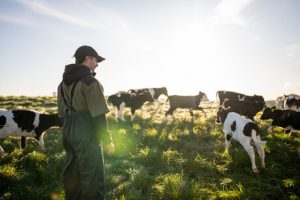
Food freedom is spreading. And there’s perhaps no better evidence of that fact than the growing number of states making it easier for farmers to sell “raw,” or unpasteurized, milk to eager consumers.
This week, the North Dakota House of Representatives passed House Bill 1515, which would legalize dairy farms to sell raw milk to consumers. “A debate over whether dairy farms should be able to sell unpasteurized milk pitted proponents of consumer freedom against advocates for public health,” the Bismarck Tribune reported this week.
Currently, farmers in North Dakota may only legally sell raw milk to consumers who purchase a share of a cow, sometimes known as a herd share.
Similar bills are currently under consideration in Iowa, Idaho, and Washington. And a Wyoming bill could expand raw-milk sales even further than would the aforementioned bills.
Raw milk is a litmus test of sorts for food freedom—which I’ve long defined as a person’s right to grow, raise, produce, buy, sell, share, and eat the foods of their own choosing.
On the one hand, opponents of raw milk, including public-health bureaucrats and the nation’s largest sellers of pasteurized milk, argue raw milk should be banned because it may contain pathogens that could sicken or kill consumers.
The FDA, which was forced by a federal judge to reverse course and ban interstate sales of raw milk in 1987, regulates a host of raw foods (from sprouts to melons to sushi) that may contain harmful pathogens. While the agency may issue warnings about and recalls of those foods when they are found to contain pathogens, on raw milk the agency’s position is an absolutist no.
“No one disputes that pasteurization helps kill harmful pathogens,” I explained in a 2011 Washington Times op-ed. “But where the FDA claims to see a mountain, most states see a molehill.”
On the other hand, “raw milk has become popular in recent years as part of the local food movement,” NPR reported in a 2015 piece on the spread of raw milk. “[Consumers] say they buy raw milk because it doesn’t contain the growth hormone rGBH, they like the taste, and they enjoy having a direct connection to the food they eat.”
Supporters also note that many conventional dairy farmers who sell pasteurized milk are struggling and that raw milk sales may provide a lifeline in the form of higher margins. In December, such an argument won the day in Wisconsin—America’s leading dairy state—when the state farm bureau reversed its longstanding opposition to legal raw milk sales.
More and more, farmers, consumers, and lawmakers are favoring such sales. As of August 2022, according to data provided by the nonprofit Farm-to-Consumer Legal Defense Fund, where I serve on the board, at least 10 states allow some form of retail sales of raw milk, at least 18 states allow on-farm sales, and at least eight states allow herd shares. A similar raw-milk map, produced in 2015 by the National Conference of State Legislatures and reproduced here, shows state laws governing raw milk sales have improved noticeably across the country in less than a decade.
None of this is to say that consuming raw milk (or any food) comes without risk—for producers and consumers alike. But driving raw milk sales underground won’t make raw milk safer, I note in my 2016 book Biting the Hands that Feed Us: How Fewer, Smarter Laws Would Make Our Food System More Sustainable. Ultimately, adults should have the right to weigh risks and make choices about the foods we eat.

























